European Union
European organization
Introduction
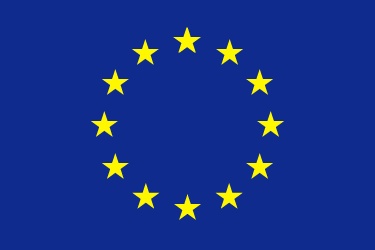
 international organization comprising 27 European countries and governing common economic, social, and security policies. Originally confined to western Europe, the EU has expanded to include several central and eastern European countries. The EU's members are Austria, Belgium, Bulgaria, Cyprus, the Czech Republic, Denmark, Estonia, Finland, France, Germany, Greece, Hungary, Ireland, Italy, Latvia, Lithuania, Luxembourg, Malta, The Netherlands, Poland, Portugal, Romania, Slovakia, Slovenia, Spain, Sweden, and the United Kingdom. The EU was created by the Maastricht Treaty, which entered into force on November 1, 1993. The treaty was designed to enhance European political and economic integration by creating a single currency (the euro), a unified foreign and security policy, common citizenship rights, and by advancing cooperation in the areas of immigration, asylum, and judicial affairs.
international organization comprising 27 European countries and governing common economic, social, and security policies. Originally confined to western Europe, the EU has expanded to include several central and eastern European countries. The EU's members are Austria, Belgium, Bulgaria, Cyprus, the Czech Republic, Denmark, Estonia, Finland, France, Germany, Greece, Hungary, Ireland, Italy, Latvia, Lithuania, Luxembourg, Malta, The Netherlands, Poland, Portugal, Romania, Slovakia, Slovenia, Spain, Sweden, and the United Kingdom. The EU was created by the Maastricht Treaty, which entered into force on November 1, 1993. The treaty was designed to enhance European political and economic integration by creating a single currency (the euro), a unified foreign and security policy, common citizenship rights, and by advancing cooperation in the areas of immigration, asylum, and judicial affairs.Origins
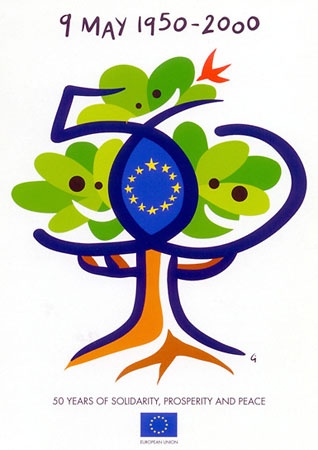 The EU represents one in a series of efforts to integrate Europe since World War II. At the end of the war, several western European countries sought closer economic, social, and political ties to achieve economic growth and military security and to promote a lasting reconciliation between France and Germany. To this end, in 1951 the leaders of six countries—Belgium, France, Italy, Luxembourg, The Netherlands, and West Germany—signed the Treaty of Paris, which founded the European Coal and Steel Community (ECSC). The ECSC created a free trade area for several key economic and military resources: coal, coke, steel, scrap, and iron ore. To manage the ECSC, the treaty established several supranational institutions: a High Authority to administrate, a Council of Ministers to legislate, a Common Assembly to formulate policy, and a Court of Justice to interpret the treaty and to resolve related disputes. A series of further international treaties and treaty revisions based largely on this model led eventually to the creation of the EU.
The EU represents one in a series of efforts to integrate Europe since World War II. At the end of the war, several western European countries sought closer economic, social, and political ties to achieve economic growth and military security and to promote a lasting reconciliation between France and Germany. To this end, in 1951 the leaders of six countries—Belgium, France, Italy, Luxembourg, The Netherlands, and West Germany—signed the Treaty of Paris, which founded the European Coal and Steel Community (ECSC). The ECSC created a free trade area for several key economic and military resources: coal, coke, steel, scrap, and iron ore. To manage the ECSC, the treaty established several supranational institutions: a High Authority to administrate, a Council of Ministers to legislate, a Common Assembly to formulate policy, and a Court of Justice to interpret the treaty and to resolve related disputes. A series of further international treaties and treaty revisions based largely on this model led eventually to the creation of the EU.Creation of the European Economic Community (European Community)
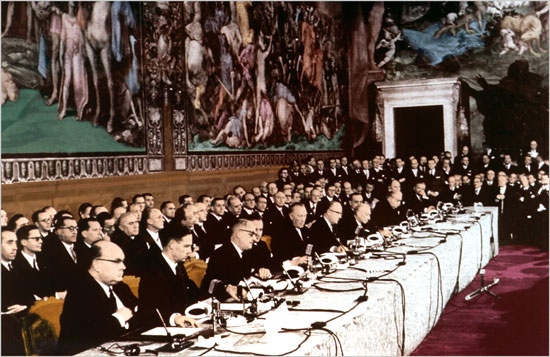 On March 25, 1957, the six ECSC members signed the two Treaties of Rome (Rome, Treaties of) that established the European Atomic Energy Community (Euratom), which was designed to facilitate cooperation in atomic energy development, research, and utilization, and the European Economic Community (EEC). The EEC created a common market that featured the elimination of most barriers to the movement of goods, services, capital, and labour, the prohibition of most public policies or private agreements that inhibit market competition, a common agricultural policy (CAP), and a common external trade policy.
On March 25, 1957, the six ECSC members signed the two Treaties of Rome (Rome, Treaties of) that established the European Atomic Energy Community (Euratom), which was designed to facilitate cooperation in atomic energy development, research, and utilization, and the European Economic Community (EEC). The EEC created a common market that featured the elimination of most barriers to the movement of goods, services, capital, and labour, the prohibition of most public policies or private agreements that inhibit market competition, a common agricultural policy (CAP), and a common external trade policy.The treaty establishing the EEC required members to eliminate or revise important national laws and regulations. In particular, it fundamentally reformed tariff and trade policy by abolishing all internal tariffs by July 1968. It also required that governments eliminate national regulations favouring domestic industries and cooperate in areas in which they traditionally had acted independently, such as international trade (i.e., trade with countries outside the EEC). The treaty called for common rules on anticompetitive and monopolistic behaviour and for common inland transportation and regulatory standards. Recognizing social policy as a fundamental component of economic integration, the treaty also created the European Social Fund, which was designed to enhance job opportunities by facilitating workers' geographic and occupational mobility.
Significantly, the treaty's common market reforms did not extend to agriculture. The CAP, which was implemented in 1962 and which became the costliest and most controversial element of the EEC and later the EU, relied on state intervention to protect the living standards of farmers, to promote agricultural self-sufficiency, and to ensure a reliable supply of products at reasonable prices.
Like the ECSC, the EEC established four major governing institutions: a commission, a ministerial council, an assembly, and a court. To advise the Commission and the Council of Ministers on a broad range of social and economic policies, the treaty created an Economic and Social Committee. In 1965 members of the EEC signed the Brussels Treaty, which merged the commissions of the EEC and Euratom (European Atomic Energy Community) and the High Authority of the ECSC into a single commission. It also combined the councils of the three organizations into a common Council of Ministers. The EEC, Euratom, and the ECSC—collectively referred to as the European Communities—later became the principal institutions of the EU.
The Commission (commonly referred to as the European Commission) consists of a permanent civil service directed by commissioners. It has had three primary functions: to formulate community policies, to monitor compliance with community decisions, and to oversee the execution of community law. Initially, commissioners were appointed by members to renewable four-year terms, which were later extended to five years. The Commission is headed by a president, who is selected by the heads of state or government of the organization's members. In consultation with member governments, the president appoints the heads of the Directorate-Generals, which manage specific areas such as agriculture, competition, the environment, and regional policy. The Commission has shared its agenda-setting role with the European Council, which consists of the leaders of all member countries. Established in 1974, the European Council meets at least twice a year to define the long-term agenda for European political and economic integration.
The main decision-making institution of the EEC and the European Community (as the EEC was renamed later) and the EU has been the Council of Ministers (now the Council of the European Union), which consists of ministerial representatives. The composition of the Council changes frequently, as governments send different representatives depending on the policy area under discussion. All community legislation requires the approval of the Council. The president of the Council, whose office rotates every six months, manages the legislative agenda.
The Common Assembly, renamed the European Parliament in 1962, originally consisted of delegates from national parliaments. Beginning in 1979, members were elected directly to five-year terms. The size of members' delegations varies depending on population. For example, at the 2004 elections, Germany had 99 representatives and Malta had 5. The Parliament is organized into transnational party groups based on political ideology—e.g., the Party of European Socialists (European Socialists, Party of), the European People's Party, the European Federation of Green Parties, and the European Liberal, Democrat and Reform Party (European Liberal Democrat and Reform Party). Until 1987 the legislature served only as a consultative body, though in 1970 it was given joint decision-making power (with the Council of Ministers) over community expenditures.
The European Court of Justice (ECJ) interprets community law, settles conflicts between the organization's institutions, and determines whether members have fulfilled their treaty obligations. Each member selects one judge, who serves a renewable six-year term; to increase efficiency, after the accession of 10 additional countries in 2004 the ECJ was allowed to sit in a “grand chamber” of only 11 judges. Eight impartial advocates-general assist the ECJ by presenting opinions on cases before the court. In 1989 an additional court, the Court of First Instance, was established to assist with the community's increasing caseload. The ECJ has established two important legal doctrines. First, European law has “direct effect,” which means that treaty provisions and legislation are directly binding on individual citizens, regardless of whether their governments have modified national laws accordingly. Second, community law has “supremacy” over national law in cases where the two conflict. Because national courts eventually accepted these legal doctrines, the ECJ has acquired a supranational legal authority.
Throughout the 1970s and '80s the EEC gradually expanded both its membership and its scope. In 1973 the United Kingdom, Denmark, and Ireland were admitted, followed by Greece in 1981 and Portugal and Spain in 1986. The community's common external trade policy generated pressure for common foreign and development policies, and in the early 1970s the European Political Cooperation (EPC; renamed the Common Foreign and Security Policy by the Maastricht Treaty), consisting of regular meetings of the foreign ministers of each country, was established to coordinate foreign policy. In 1975 the European Regional Development Fund was created to address regional economic disparities and to provide additional resources to Europe's most deprived areas. In the same year, members endorsed the Lomé Convention, a development-assistance package and preferential-trade agreement with numerous African, Caribbean, and Pacific countries. Members also made several attempts to manage their exchange rates collectively, resulting in the establishment of the European Monetary System in 1979.
Single European Act
 The Single European Act (SEA), which entered into force on July 1, 1987, significantly expanded the EEC's scope. It gave the meetings of the EPC a legal basis, and it called for more intensive coordination of foreign policy among members, though foreign policy decisions were made outside community institutions. The agreement brought the European Regional Development Fund formally into the community's treaties as part of a new section on economic and social cohesion that aimed to encourage the development of economically depressed areas. As a result of the act, there was a substantial increase in funding for social and regional programs. The SEA also required the community's economic policies to incorporate provisions for the protection of the environment, and it provided for a common research and technological-development policy, which was aimed primarily at funding transnational research efforts.
The Single European Act (SEA), which entered into force on July 1, 1987, significantly expanded the EEC's scope. It gave the meetings of the EPC a legal basis, and it called for more intensive coordination of foreign policy among members, though foreign policy decisions were made outside community institutions. The agreement brought the European Regional Development Fund formally into the community's treaties as part of a new section on economic and social cohesion that aimed to encourage the development of economically depressed areas. As a result of the act, there was a substantial increase in funding for social and regional programs. The SEA also required the community's economic policies to incorporate provisions for the protection of the environment, and it provided for a common research and technological-development policy, which was aimed primarily at funding transnational research efforts.More generally, the SEA set out a timetable for the completion of a common market. A variety of legal, technical, fiscal, and physical barriers continued to limit the free movement of goods, labour, capital, and services. For example, differences in national health and safety standards for consumer goods were a potential impediment to trade. To facilitate the completion of the common market by 1992, the community's legislative process was modified. Originally, the Commission proposed legislation, the Parliament was consulted, and the Council of Ministers made a final decision. The Council's decisions generally needed unanimity, a requirement that gave each member a veto over all legislation. The SEA introduced qualified majority voting for all legislation related to the completion of the common market. Under this system, each member was given multiple votes, the number of which depended on national population, and approval of legislation required roughly two-thirds of the votes of all members. The new procedure also increased the role of the European Parliament. Specifically, legislative proposals that were rejected by the Parliament could be adopted by the Council of Ministers only by a unanimous vote.
The Maastricht Treaty
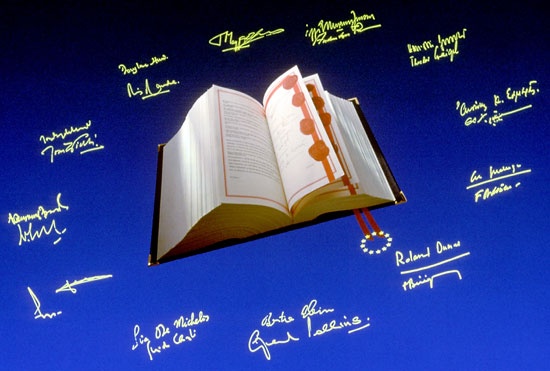 The Maastricht Treaty (formally known as the Treaty on European Union), which was signed on February 7, 1992, created the European Union. The treaty met with substantial resistance in some countries. In Denmark, for example, voters who were worried about infringements upon their country's sovereignty defeated a referendum on the original treaty in June 1992, though a revised treaty was approved the following May. Voters in France narrowly approved the treaty in September, and in July 1993 British Prime Minister John Major (Major, John) was forced to call a vote of confidence in order to secure its passage. An amended version of the treaty officially took effect on November 1, 1993.
The Maastricht Treaty (formally known as the Treaty on European Union), which was signed on February 7, 1992, created the European Union. The treaty met with substantial resistance in some countries. In Denmark, for example, voters who were worried about infringements upon their country's sovereignty defeated a referendum on the original treaty in June 1992, though a revised treaty was approved the following May. Voters in France narrowly approved the treaty in September, and in July 1993 British Prime Minister John Major (Major, John) was forced to call a vote of confidence in order to secure its passage. An amended version of the treaty officially took effect on November 1, 1993.The treaty consisted of three main pillars: the European Communities, a common foreign and security policy, and enhanced cooperation in home (domestic) affairs and justice. The treaty changed the name of the European Economic Community to the European Community, which became the primary component of the new European Union. The agreement gave the EC broader authority, including formal control of community policies on development, education, public health, and consumer protection and an increased role in environmental protection, social and economic cohesion, and technological research. It also established EU citizenship, which entailed the right of EU citizens to vote and to run for office in local and European Parliament elections in their country of residence, regardless of national citizenship.
The Maastricht Treaty specified an agenda for incorporating monetary policy into the EC and formalized planning that had begun in the late 1980s to replace national currencies with a common currency (euro) managed by common monetary institutions. The treaty defined a set of “convergence criteria” that specified the conditions under which a member would qualify for participation in the common currency. Countries were required to have annual budget deficits not exceeding 3 percent of gross domestic product (GDP), public debt under 60 percent of GDP, inflation rates within 1.5 percent of the three lowest inflation rates in the EU, and exchange-rate stability. The members that qualified were to decide whether to proceed to the final stage—the adoption of a single currency. The decision required the establishment of permanent exchange rates and, after a transition period, the replacement of national currencies with the common currency, called the euro. Although several countries failed to meet the convergence criteria (e.g., in Italy and Belgium public debt exceeded 120 percent of GDP), the Commission qualified nearly all members for monetary union, and on January 1, 1999, 11 countries—Austria, Belgium, Finland, France, Germany, Ireland, Italy, Luxembourg, The Netherlands, Portugal, and Spain—adopted the currency and relinquished control over their exchange rates. Greece failed to qualify, and Denmark, Sweden, and the United Kingdom chose not to apply for membership. Greece was admitted to the euro beginning in 2001. Initially used only by financial markets and businesses, the euro was introduced for use by the general public on January 1, 2002.
The Maastricht Treaty significantly modified the EEC's institutions and decision-making processes. The Commission was reformed to increase its accountability to the Parliament. Beginning in 1995, the term of office for commissioners, who now had to be approved by the Parliament, was lengthened to five years to correspond to the terms served by members of the Parliament. The ECJ was granted the authority to impose fines on members for noncompliance. Several new institutions were created, including the European Central Bank, the European System of Central Banks, and the European Monetary Institute. The treaty also created a regional committee, which served as an advisory body for commissioners and the Council of Ministers on issues relevant to subnational, regional, or local constituencies.
One of the most radical changes was the reform of the legislative process. The range of policies subject to qualified majority voting in the Council of Ministers was broadened. The treaty also endowed the Parliament with a limited right of rejection over legislation in most of the areas subject to qualified majority voting, and in a few areas, including citizenship, it was given veto power. The treaty formally incorporated the Court of Auditors, which was created in the 1970s to monitor revenue and expenditures, into the EC.
As part of the treaty's second pillar, members undertook to define and implement common foreign and security policies. Members agreed that, where possible, they would adopt common defense policies, which would be implemented through the Western European Union, a security organization that includes many EU members. Joint actions—which were not subject to monitoring or enforcement by the Commission or the ECJ—required unanimity.
The EU's third pillar included several areas of common concern related to the free movement of people within the EU's borders. The elimination of border controls conflicted with some national immigration, asylum, and residency policies and made it difficult to combat crime and to apply national civil codes uniformly, thus creating the need for new Europe-wide policies. For example, national asylum policies that treated third-country nationals differently could not, in practice, endure once people were allowed to move freely across national borders.
Enlargement and post-Maastricht reforms
On January 1, 1995, Sweden, Austria, and Finland joined the EU, leaving Iceland, Norway, and Switzerland as the only major western European countries outside the organization. Norway's government twice (1972 and 1994) attempted to join, but its voters rejected membership on each occasion. Switzerland tabled its application in the early 1990s. Norway, Iceland, and the members of the EU (along with Liechtenstein) are members of a free trade area called the European Economic Area, which allows freedom of movement for goods, services, capital, and people.
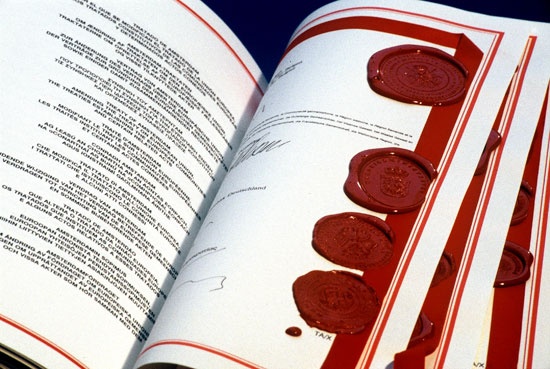 Two subsequent treaties revised the policies and institutions of the EU. The first, the Treaty of Amsterdam, was signed in 1997 and entered into force on May 1, 1999. Building on the social protocol of the Maastricht Treaty, it identified as EU objectives the promotion of employment, improved living and working conditions, and proper social protection; added sex-discrimination protections and transferred asylum, immigration, and civil judicial policy to the community's jurisdiction; granted the Council of Ministers the power to penalize members for serious violations of fundamental human rights; and gave the Parliament veto power over a broad range of EC policies as well as the power to reject the European Council's nominee for president of the Commission.
Two subsequent treaties revised the policies and institutions of the EU. The first, the Treaty of Amsterdam, was signed in 1997 and entered into force on May 1, 1999. Building on the social protocol of the Maastricht Treaty, it identified as EU objectives the promotion of employment, improved living and working conditions, and proper social protection; added sex-discrimination protections and transferred asylum, immigration, and civil judicial policy to the community's jurisdiction; granted the Council of Ministers the power to penalize members for serious violations of fundamental human rights; and gave the Parliament veto power over a broad range of EC policies as well as the power to reject the European Council's nominee for president of the Commission.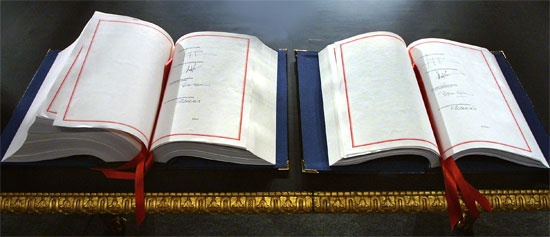 A second treaty, the Treaty of Nice, was signed in 2001 and entered into force on February 1, 2003. Negotiated in preparation for the admission of new members from eastern Europe, it contained major reforms. The maximum number of seats on the Commission was set at 27, the number of commissioners appointed by members was made the same at one each, and the president of the Commission was given greater independence from national governments. Qualified majority voting in the Council of Ministers was extended to several new areas. Approval of legislation by qualified voting required the support of members representing at least 62 percent of the EU population and either the support of a majority of members or a supermajority of votes cast. Although national vetoes remained in areas such as taxation and social policy, countries choosing to pursue further integration in limited areas were not precluded from doing so.
A second treaty, the Treaty of Nice, was signed in 2001 and entered into force on February 1, 2003. Negotiated in preparation for the admission of new members from eastern Europe, it contained major reforms. The maximum number of seats on the Commission was set at 27, the number of commissioners appointed by members was made the same at one each, and the president of the Commission was given greater independence from national governments. Qualified majority voting in the Council of Ministers was extended to several new areas. Approval of legislation by qualified voting required the support of members representing at least 62 percent of the EU population and either the support of a majority of members or a supermajority of votes cast. Although national vetoes remained in areas such as taxation and social policy, countries choosing to pursue further integration in limited areas were not precluded from doing so.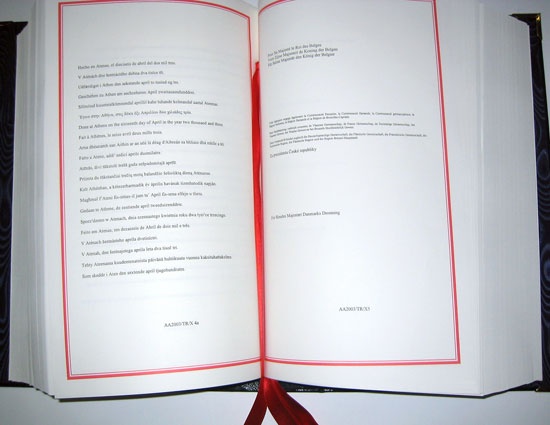 After the end of Cold War, many of the former communist countries of eastern and central Europe applied for EU membership. However, their relative lack of economic development threatened to hinder their full integration into EU institutions. To address this problem, the EU considered a stratified system under which subsets of countries would participate in some components of economic integration (e.g., a free trade area) but not in others (e.g., the single currency). Turkey, at the periphery of Europe, also applied for membership, though its application was controversial because it was a predominantly Islamic country, because it was widely accused of human rights violations, and because it had historically tense relations with Greece (especially over Cyprus). Despite opposition from those who feared that expansion of the EU would stifle consensus and inhibit the development of Europe-wide foreign and security policies, the EU in 2004 admitted 10 countries (Cyprus, the Czech Republic, Estonia, Hungary, Latvia, Lithuania, Malta, Poland, Slovakia, and Slovenia), all but two of which (Cyprus and Malta) were former communist states; Bulgaria and Romania joined in 2007. Negotiations on Turkey's membership application began in 2005 but faced numerous difficulties.
After the end of Cold War, many of the former communist countries of eastern and central Europe applied for EU membership. However, their relative lack of economic development threatened to hinder their full integration into EU institutions. To address this problem, the EU considered a stratified system under which subsets of countries would participate in some components of economic integration (e.g., a free trade area) but not in others (e.g., the single currency). Turkey, at the periphery of Europe, also applied for membership, though its application was controversial because it was a predominantly Islamic country, because it was widely accused of human rights violations, and because it had historically tense relations with Greece (especially over Cyprus). Despite opposition from those who feared that expansion of the EU would stifle consensus and inhibit the development of Europe-wide foreign and security policies, the EU in 2004 admitted 10 countries (Cyprus, the Czech Republic, Estonia, Hungary, Latvia, Lithuania, Malta, Poland, Slovakia, and Slovenia), all but two of which (Cyprus and Malta) were former communist states; Bulgaria and Romania joined in 2007. Negotiations on Turkey's membership application began in 2005 but faced numerous difficulties.Building on the limited economic and political goals of the ECSC, the countries of western Europe have achieved an unprecedented level of integration and cooperation. The degree of legal integration, supranational political authority, and economic integration in the EU greatly surpasses that of other international organizations. Indeed, although the EU has not replaced the nation-state, its institutions have increasingly resembled a parliamentary democratic political system at the supranational level.
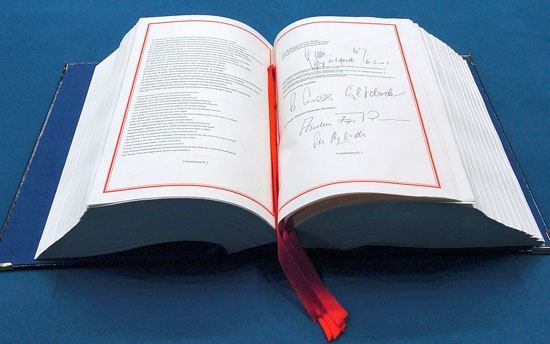 In 2002 the Convention on the Future of Europe, chaired by former French president Valéry Giscard d'Estaing (Giscard d'Estaing, Valéry), was established to draft a constitution for the enlarged EU. Among the most difficult problems confronting the framers of the document was how to distribute power within the EU between large and small members and how to adapt the organization's institutions to accommodate a membership that would be more than four times larger than that of the original EEC. The framers also needed to balance the ideal of deeper integration against the goal of protecting members' national traditions. The drafting process evoked considerable controversy, particularly over the question of whether the constitution should mention God and the Christian heritage of much of European society (the final version did not). The proposed constitution was signed in 2004 but required ratification by all EU members to take effect; voters in France and The Netherlands rejected it in 2005, thereby scuttling the constitution at least in the short term. It would have created a full-time president, a European foreign minister, a public prosecutor, and a charter of fundamental rights. Under the constitution the powers of the European Parliament would have been greatly expanded and the EU given a “legal personality” that entailed the sole right to negotiate most treaties on its members' behalf.
In 2002 the Convention on the Future of Europe, chaired by former French president Valéry Giscard d'Estaing (Giscard d'Estaing, Valéry), was established to draft a constitution for the enlarged EU. Among the most difficult problems confronting the framers of the document was how to distribute power within the EU between large and small members and how to adapt the organization's institutions to accommodate a membership that would be more than four times larger than that of the original EEC. The framers also needed to balance the ideal of deeper integration against the goal of protecting members' national traditions. The drafting process evoked considerable controversy, particularly over the question of whether the constitution should mention God and the Christian heritage of much of European society (the final version did not). The proposed constitution was signed in 2004 but required ratification by all EU members to take effect; voters in France and The Netherlands rejected it in 2005, thereby scuttling the constitution at least in the short term. It would have created a full-time president, a European foreign minister, a public prosecutor, and a charter of fundamental rights. Under the constitution the powers of the European Parliament would have been greatly expanded and the EU given a “legal personality” that entailed the sole right to negotiate most treaties on its members' behalf.Under the leadership of Germany, work began in early 2007 on a reform treaty intended to replace the failed constitution. The resulting Lisbon Treaty, signed in December 2007, required approval by all 27 EU member countries in order to be ratified as scheduled in 2008. The treaty, which retained portions of the draft constitution, would have established an EU presidency, consolidated foreign policy representation for the EU, and devolved additional powers to the European Commission, the European Court of Justice, and the European Parliament. Unlike the draft constitution, the Lisbon Treaty would have amended rather than replaced existing treaties. The treaty failed, at least in the short term, in June 2008 after it was rejected by voters in a national referendum in Ireland.
Additional Reading
General overviews of the EU are provided in Desmond Dinan, Ever Closer Union: An Introduction to European Integration, 2nd ed. (1999); and Neill Nugent, The Government and Politics of the European Union, 5th ed. (2003). The diplomatic and political history of European integration is discussed in Alan S. Milward, The European Rescue of the Nation-State, 2nd ed. (2000); and Andrew Moravcsik, The Choice for Europe: Social Purpose and State Power from Messina to Maastricht (1998). A detailed discussion of the various EU institutions is Simon Hix, The Political System of the European Union, 2nd ed. (2003). Economic studies include Ali M. El-Agraa, The European Union: Economics and Policies, 7th ed. (2004); and Loukas Tsoukalis, The New European Economy Revisited, 3rd ed. (1997).
- Gilbert, Sir W.S.
- Gilbert Sorrentino
- Gilbert Stuart
- Gilbert Tennent
- Gilbert, Walter
- Gilbert White
- Gilbert, William
- Gilbreth, Frank Bunker
- Gilbreth, Lillian Evelyn
- Gilchrist, Percy
- Gildas
- Gilded Age
- Gil de Hontañón, Juan
- Gil de Hontañón, Rodrigo
- Gilder, Jeannette Leonard
- Gil de Siloé
- gilding
- Gildo
- Gilead
- Gilels, Emil
- Giles Cooper
- Giles Farnaby
- Giles Fletcher, the Elder
- Giles Fletcher, the Younger
- Giles, H.A.